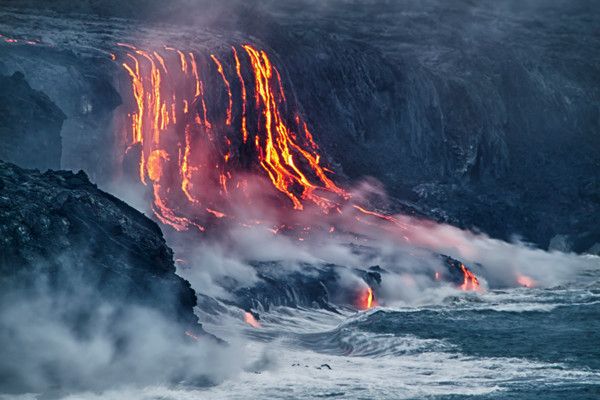
by Mary Caperton Morton Friday, August 29, 2014

Kilauea is the most active of the five volcanoes that form the Big Island of Hawaii and one of the most continuously active volcanoes in the world. Credit: ©Shutterstock.com/Alexey Kamenskiy.
Hawaii’s Kilauea volcano is famously effusive: Low-viscosity lava oozes out of the main caldera and two active rift zones along the southern shore of the Big Island. But scientists suspect that Kilauea’s eruptions haven’t always been so mild, and a new study is providing further evidence supporting that notion. In the past 2,500 years, at least two cycles of explosive eruptions lasting several centuries each have rocked the island. The switch from effusive back to explosive is likely to occur again, scientists say, but probably not anytime soon.
Ash deposits left by past explosive eruptions have long been identified on the Big Island, but how the ash layers fit into the larger eruptive history of Kilauea was not well understood. “Explosive deposits have been recognized since the early days of study at Kilauea, but [this new study] really tells the whole story of the volcano’s eruptive history,” says Michael Poland, a geophysicist at the Hawaiian Volcano Observatory (HVO) in Hawaii Volcanoes National Park who was not involved in the study.
Using detailed stratigraphic studies, combined with radiocarbon dating of past lava flows, lead author Donald Swanson, of the University of Washington and HVO, and colleagues reconstructed the eruptive history of Kilauea going back two and a half millennia. They found that the volcano has experienced alternating periods of effusive and explosive activity, each lasting several centuries, which they detailed in Geology.
The biggest remaining gaps in understanding center on the question of what triggers the switch from effusive to explosive and back again, Swanson says. Explosive eruptions seem to be triggered when magma comes in contact with the water table, suggesting that a deepening caldera may be one ingredient for the switch; today the caldera sits about 600 meters above the water table. Explosive eruptions also seem to be associated with a limited magma supply rate, which may occur when Mauna Loa is more active. Mauna Loa is thought by some researchers to divert lava away from Kilauea at certain times. “It seems that several different factors are interrelated and linked in ways we don’t quite understand yet,” Swanson says.
The current effusive cycle started about 200 years ago and is likely to continue for some time, he says. “We don’t know when the next explosive cycle might begin. It’s not going to be next year or next decade, but who knows about next century.”
Whether other primarily effusive volcanoes, such as those in Iceland, South Africa and India, might share the same alternating pattern of effusive and explosive activity is unknown, but it’s possible, Swanson says. “I see no reason why Kilauea would be unique so I think it’s definitely worthwhile to look for similar evidence elsewhere,” he says. “If this pattern is found in other volcanoes, it may suggest that the source of the alternating cycles is a deep-seated process rooted in the mantle.”
© 2008-2021. All rights reserved. Any copying, redistribution or retransmission of any of the contents of this service without the expressed written permission of the American Geosciences Institute is expressly prohibited. Click here for all copyright requests.